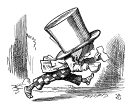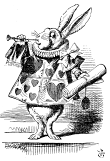Search us!
Search The Word Detective and our family of websites:
This is the easiest way to find a column on a particular word or phrase.
To search for a specific phrase, put it between quotation marks. (note: JavaScript must be turned on in your browser to view results.)
Ask a Question! Puzzled by Posh?
Confounded by Cattycorner?
Baffled by Balderdash?
Flummoxed by Flabbergast?
Perplexed by Pandemonium?
Nonplussed by... Nonplussed?
Annoyed by Alliteration?

Don't be shy!
Send in your question!
Columns from 1995 to 2006 are slowly being added to the above archives. For the moment, they can best be found by using the Search box at the top of this column.
 If you would like to be notified when each monthly update is posted here, sign up for our free email notification list.
If you would like to be notified when each monthly update is posted here, sign up for our free email notification list.
Trivia
All contents herein (except the illustrations, which are in the public domain) are Copyright © 1995-2020 Evan Morris & Kathy Wollard. Reproduction without written permission is prohibited, with the exception that teachers in public schools may duplicate and distribute the material here for classroom use.
Any typos found are yours to keep.
And remember, kids,
Semper Ubi Sub Ubi
|
And I used to be lots funnier.
Dear Word Detective: My friend drives a Mazda car. She thinks that the word “mazda” has some significant meaning, possibly in ancient Persian. Can you give me any information? –Peter Kerr.
Drat. I was all set to cast light-hearted doubt on your friend’s sanity when a little voice in my head suggested that I check a book called From Altoids to Zima: The Surprising Stories Behind 125 Famous Brand Names (Simon & Schuster, 2004). Inasmuch as I actually wrote this book my very own self, you’d think I’d remember what it contains, but you’d be wrong. The truth about many writers is that once the research is done and the piece is written and published, we wipe the old memory slate clean to make room for shopping lists and dental appointments. Occasionally this “yesterday’s gone” approach proves awkward (as it almost just did), but the bright side is that I can amuse myself for hours reading things I wrote just a few months ago.
In any case, your friend is correct. The Mazda car, produced by the Mazda Motor Company of Japan, takes its name from Ahura Mazda, the central deity of Zoroastrianism, an ancient Persian religion. Zoroastrianism, one of the oldest monotheistic religions, is considered to have been a strong influence on the Abrahamic religions (including Christianity, Judaism and Islam), and was founded by the Persian philosopher Zoroaster, also known as Zarathustra. Evidently Zoroastrianism also strongly influenced Jujiro Matsuda, the founder of Mazda Motor Company. Matsuda, son of a fisherman, founded the company in 1920 under the name Toyo Cork Kogyo Co., Ltd., and, indeed, produced cork flooring until switching to motor vehicles in 1931. Oddly enough, the company’s name formally became Mazda Motor Company only in 1984, but every vehicle they have produced, including their 1931 Mazdago three-wheel pickup truck, has carried some variant of the “Mazda” name.
There is a theory that Jujiro Matsuda picked the name “Mazda” not only from an apparent respect for Zoroastrianism but also because it bore a strong phonetic resemblance to his own last name. If that’s true, Mazda is in good company — many automobile brands are based on personal names. The Oldsmobile, for instance, was named for Ransom E. Olds, a pioneer automobile engineer who established the first car company in Detroit, the Olds Motor Company, in 1890. Rolls-Royce was founded by Charles Stewart Rolls and Frederick Henry Royce in 1906, and Dodge honors John and Horace Dodge, brothers who started out making bicycles and eventually worked up to manufacturing cars. Honda and Toyota both reflect the names of their founders, although in the latter case “Toyota” was thought to have a “better sound” than Sakichi Toyoda’s last name. And while the French explorer Antoine de la Mothe Cadillac (1656-1750) never got around to building a car, his name is immortalized on those tacky hood ornaments today because he founded the city of Detroit.
Ook at its iddle PAWS!
Dear Word Detective: “Glaikit” is a word of Scottish origin, meaning a silly, sappy expression on one’s face. Where did it come from? — Tim.
Good question. “Glaikit” is a new one on me, but I certainly know the expression it apparently describes. It’s the look otherwise sane people get when they see the kittens our local pet store has up for adoption. I was in there the other day, buying a 20-pound bag of gourmet cat chow, and there were at least five full-grown customers peering into the cage, emitting the sort of cooing and kissing sounds that would get you arrested if you made them on the subway. I wouldn’t dream of discouraging anyone willing to adopt a cat, but I do wonder if they’ll still be cooing when the little critter mistakes their legs for the fancy-schmancy scratching post they bought it.
“Glaikit” is indeed mostly heard in Scotland and northern England, and according to the Oxford English Dictionary (OED), it’s an adjective originally, when it first appeared in the mid-15th century, meaning “senseless, foolish.” In later usage, it expanded a bit to include “thoughtless, flighty and giddy,” uses most frequently applied to women.
Tracing the origins of “glaikit” leads us into a bit of a maze. It is pretty certainly related to the noun “glaik,” also of Scots parentage, which means (according to the OED) “mocking deception,” most often used in phrases such as “to give one the glaiks,” meaning to cheat or swindle. “Glaik” as a noun has also been used to mean “a child’s puzzle,” “a flash of light” and as an expression of contempt for another person. There’s also a derivative verb, “to glaik,” meaning, variously, “to stare idly,” “to delude” and “to dazzle.” If this all seems a bit hazy and confusing, welcome to the club.
The probable root of “glaik” (and I’m glad there is one) is the only slightly less weird word “gleek,” which is now considered obsolete but in its day meant “a jibe or jest,” often in the phrase “to give someone the gleek,” meaning to trick or make fun of the person. Tracing “gleek” a bit further back, we find, at long last, a familiar word. The root of “gleek” turns out to be “glee,” which, although now most often used to mean “a feeling of delight,” originally meant “play or sport,” especially in the “mocking jest” sense.
So, to sum up, “glaikit” meaning basically “foolish” can be traced back to “glee” meaning “jest or trick.”
The better to bite you with, Sarge.
Dear Word Detective: At lunch today we were speaking of the draft (the military sort, not the wind sort) and my lunch buddy claimed that the designation “4-F” came from the Civil War when they used muskets (first hogwash point) and men had to use their front teeth to dislodge the plug in the powder container they carried. Doing this task required four teeth in front, both upper and lower, and if a chap were lacking in those natural dental implements he was called “4-F” (for “four front”). The whole thing sounded like utter folk etymological claptrap. What say you, oh wise and noble Word Maven of the Western World (WMWM)? — Swami Murugananda.
WMWM? Based on some of the irate email I get, I’ve always thought of myself as more of a YMMV (Your Mileage May Vary) kind of guy. Remember, kids, you can’t please all of the people all of the time, so make the Delete key your friend.
In any case, your nonsense detector seems to be working quite well. The story your buddy came up with is, as you suspect, utter claptrap. On your first hogwash point, however, I think your detector is set a bit too high. Muskets (smooth-bore shoulder-fired firearms) were indeed used in the American Civil War, along with rifles (spiral grooves in the barrel), carbines (short rifles), and a wide variety of revolvers and pistols.
The “show us your teeth” explanation of “4-F” founders on several points. Although there was military conscription during the Civil War, I can find no evidence that a detailed system of draft classification, let alone the label “4-F,” existed at that time. Even if such a system had been in effect, it’s very unlikely that a single criterion, inability to open a powder pouch, would have rated a special classification when so many other disabilities (blindness, deafness, etc.) would also have disqualified the draftee. And even if one needed, and lacked, front teeth to fire a musket, there were plenty of openings for mule drivers and clerks.
As to what “4-F” actually means, the answer is pretty much nothing. During and following World War I, there was a classification system that divided conscripts into Class I (qualified for military service) and Classes II through V (unqualified or exempt). A more detailed system during and after the Second World War included 52 separate classifications, from I-A (Welcome to the Army) to IV-A (Go home, Grandpa), including IV-F, “Rejected for military service for physical, mental, or moral reasons.” The same general categories were retained after WW II with some additions, such as the ever-popular “2-S” or “student” deferment. Although the “F” in “4-F” may have been partly inspired by “fail” (or the school grade “F”), it didn’t officially stand for anything.
|
Makes a great gift! Click cover for more.  
400+ pages of science questions answered and explained for kids -- and adults!
FROM ALTOIDS TO ZIMA, by Evan Morris
 
|


 can be found
can be found 




Recent Comments